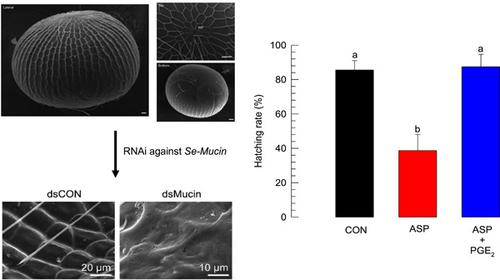当前位置:
X-MOL 学术
›
Arch. Insect Biochem. Physiol.
›
论文详情
Our official English website, www.x-mol.net, welcomes your feedback! (Note: you will need to create a separate account there.)
An ovary‐specific mucin is associated with choriogenesis mediated by prostaglandin signaling in Spodoptera exigua
Archives of Insect Biochemistry and Physiology ( IF 2.2 ) Pub Date : 2020-10-10 , DOI: 10.1002/arch.21748 Shabbir Ahmed 1 , Kiwon Seo 1 , Yonggyun Kim 1
Archives of Insect Biochemistry and Physiology ( IF 2.2 ) Pub Date : 2020-10-10 , DOI: 10.1002/arch.21748 Shabbir Ahmed 1 , Kiwon Seo 1 , Yonggyun Kim 1
Affiliation

|
Polytrophic ovarioles of Spodoptera exigua, a lepidopteran insect, begins with the development of oocytes and differentiation of nurse cells followed by vitellogenesis and choriogenesis. Compared with previtellogenic and vitellogenic developments, choriogenesis has not been clearly understood yet in endocrine control. This study investigated the expression and function of a mucin‐like structural protein of S. exigua called Se‐Mucin1 in choriogenesis. It was highly expressed in ovarioles containing chorionated oocytes. The expression level of Se‐Mucin1 was increased during adult stage as early as 18 h after adult emergence, reaching the maximal level at 24 h and later. Interestingly, DNA amount of Se‐Mucin1 was increased by almost four folds during early adult stage while other genes (hexokinase and glyceraldehyde‐3‐phosphate dehydrogenase) not directly associated with chorion formation did not show genomic DNA increase, suggesting specific gene amplification of Se‐Mucin1. RNA interference (RNAi) suppressed Se‐Mucin1 expression by injecting 1 μg of double‐strand RNA to teneral females (<5 h after emergence), which exhibited significantly impaired fecundity and egg hatching rate. Eggs laid by RNAi‐treated females were malformed in eggshell structures with loss of mesh‐like fibers. Treatment with aspirin, a prostaglandin (PG) biosynthesis inhibitor, suppressed the induction of Se‐Mucin1 expression during early adult stage and impaired egg development. An addition of PGE2 significantly rescued such impairment in Se‐Mucin1 expression and subsequent egg development. These results suggest that PGs mediate choriogenesis of S. exigua by activating the expression of chorion‐associated genes including Se‐Mucin1.
中文翻译:

卵巢特异粘蛋白与斜纹夜蛾中前列腺素信号传导介导的绒毛发生有关。
鳞翅目昆虫夜蛾(Spodoptera exigua)的多营养性卵泡始于卵母细胞的发育和护士细胞的分化,然后是卵黄发生和绒毛发生。与玻璃体形成和卵黄形成的发展相比,绒毛膜的内分泌控制尚不清楚。本实验研究的粘蛋白样结构蛋白的表达和功能甜菜夜蛾称为硒Mucin1在choriogenesis。它在含有绒毛膜卵母细胞的卵巢中高表达。早在成年后18 h,成年期Se-Mucin1的表达水平增加,在24 h及以后达到最高水平。有趣的是,Se-Mucin1的DNA量在成年早期阶段,其表达几乎增加了四倍,而与绒毛膜形成不直接相关的其他基因(己糖激酶和3-磷酸甘油醛脱氢酶)未显示出基因组DNA的增加,表明Se-Mucin1的特定基因扩增。RNA干扰(RNAi)通过向雌性雌性雌性动物(出苗后<5 h)注射1μg双链RNA抑制Se-Mucin1表达,这显着削弱了繁殖力和卵孵化率。经RNAi处理的雌性产下的卵在蛋壳结构中畸形,失去网状纤维。阿司匹林(一种前列腺素(PG)生物合成抑制剂)治疗抑制了Se-Mucin1的诱导在成年早期表达异常和卵发育受损。PGE 2的添加可显着挽救Se-Mucin1表达和随后卵发育中的此类损伤。这些结果表明,PGs通过激活包括Se-Mucin1在内的绒毛膜相关基因的表达来介导S. exigua的绒毛膜形成。
更新日期:2020-10-10
中文翻译:

卵巢特异粘蛋白与斜纹夜蛾中前列腺素信号传导介导的绒毛发生有关。
鳞翅目昆虫夜蛾(Spodoptera exigua)的多营养性卵泡始于卵母细胞的发育和护士细胞的分化,然后是卵黄发生和绒毛发生。与玻璃体形成和卵黄形成的发展相比,绒毛膜的内分泌控制尚不清楚。本实验研究的粘蛋白样结构蛋白的表达和功能甜菜夜蛾称为硒Mucin1在choriogenesis。它在含有绒毛膜卵母细胞的卵巢中高表达。早在成年后18 h,成年期Se-Mucin1的表达水平增加,在24 h及以后达到最高水平。有趣的是,Se-Mucin1的DNA量在成年早期阶段,其表达几乎增加了四倍,而与绒毛膜形成不直接相关的其他基因(己糖激酶和3-磷酸甘油醛脱氢酶)未显示出基因组DNA的增加,表明Se-Mucin1的特定基因扩增。RNA干扰(RNAi)通过向雌性雌性雌性动物(出苗后<5 h)注射1μg双链RNA抑制Se-Mucin1表达,这显着削弱了繁殖力和卵孵化率。经RNAi处理的雌性产下的卵在蛋壳结构中畸形,失去网状纤维。阿司匹林(一种前列腺素(PG)生物合成抑制剂)治疗抑制了Se-Mucin1的诱导在成年早期表达异常和卵发育受损。PGE 2的添加可显着挽救Se-Mucin1表达和随后卵发育中的此类损伤。这些结果表明,PGs通过激活包括Se-Mucin1在内的绒毛膜相关基因的表达来介导S. exigua的绒毛膜形成。


























 京公网安备 11010802027423号
京公网安备 11010802027423号